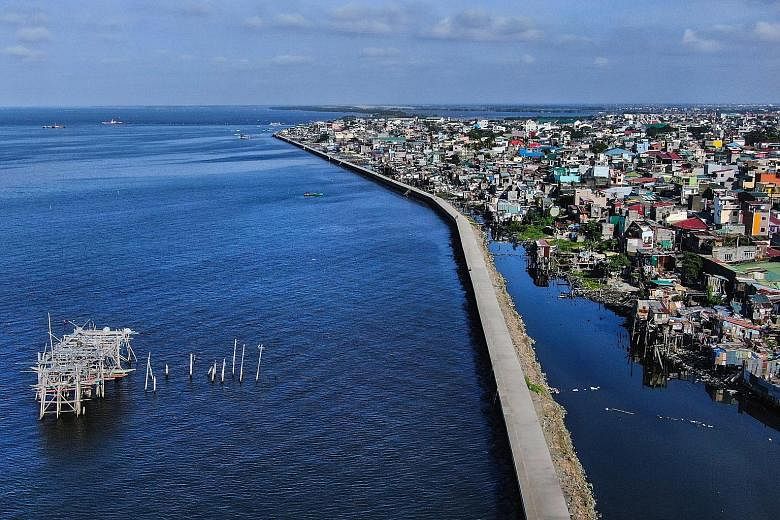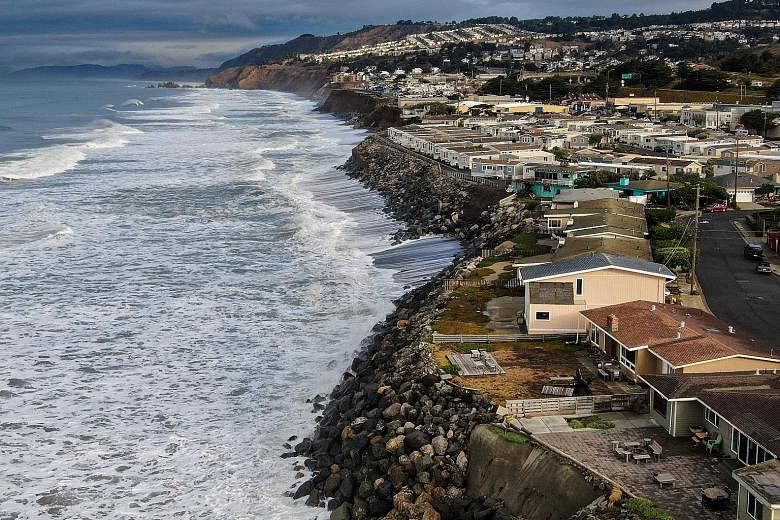MANILA/SAN FRANCISCO • An estimated 600 million people live on the world's coastlines, among the most hazardous places to be in the era of climate change. According to scientific projections, oceans stand to rise by about 30cm to 120cm by the end of the century, with projections of more ferocious storms and higher tides that could upend the lives of entire communities.
Two sprawling metropolitan areas offer a glimpse of the future. One rich, one poor, they sit on opposite sides of the Pacific Ocean: the San Francisco Bay Area (population of seven million) in the United States, and metropolitan Manila (almost 14 million) in the Philippines.
They face tough choices. They could move people out of harm's way. Or they could try raising their defences. How they deal with their circumstances today may offer lessons for coastal cities elsewhere.
METROPOLITAN MANILA; RISING WATER, SINKING CITY
Ms Desiree Alay-ay is in the thick of trade-offs. Ms Alay-ay, 30, grew up in a low-lying, flood-prone Malabon neighbourhood on the northern fringe of Manila. It is not what she wants for her newborn baby. She wants to move and take her parents with her.
But they had other plans. Leave the baby with us, her mother, Ms Zucema Rebaldo, offered. But we're not moving, this is our home, she said. "I want my baby to have a good future," said Ms Alay-ay. "I don't want him to experience what I've experienced."
Climate change has exacerbated a long-time problem in Manila. Because of a proliferation of fish ponds and the rapid extraction of groundwater, the ground has been subsiding. As a result, since the early 1990s, sea levels have risen by as much as 5cm to 7cm a year, double the global average.
Storms repeatedly sweep away spindly-legged bamboo and tin houses on the water. People flee for a while, only to come back because they have nowhere better to go. In low-lying neighbourhoods like Ms Alay-ay's, roads have been raised multiple times. Pariahan, a village just north of the city line, is now permanently underwater.
Ms Alay-ay's dilemma is magnified manifold in a megacity like Manila. Millions of the city's poorest live in hazardous, low-lying areas that are already lashed by tropical storms.
Forcing people to move away from the coast is not enough, said Ms Antonia Yulo-Loyzaga, a member of the board of directors of the Manila Observatory research organisation. They need to be able to find work nearby or an efficient public transportation system to get there. That does not exist now; average commutes are two hours or more each way.
"You need some sort of rational, organised retreat from the coast," she said. "There's no option unless you want people to live in constant fear."
SAN FRANCISCO BAY AREA; A POLITICAL LIGHTNING ROD
A rising sea underscores the missteps of the past in the Bay Area, too. The Pacific has risen 10cm to 20cm along the Northern California shore over the last century - and so, too, the San Francisco Bay, the ocean's largest estuary in the Americas.
That is why the California Coastal Commission has encouraged city governments to start planning for the future - by fortifying their flood defences, restoring wetlands or, in some instances, making people move.
That is as difficult in the Bay Area as it is in Manila. "People's properties and investments are at risk," said Mr Jack Ainsworth, head of the commission. "It becomes very political and very emotional."
Unlike Manila, Bay Area municipalities are wealthy. And many of them are already paying handsomely to fortify high-value coastal infrastructure at risk.
Voters in San Francisco have approved a US$425 million (S$591.5 million) bond measure to start fortifying a sea wall along the bay-front road, the Embarcadero. Along the road sits some of the city's most expensive real estate; below it sits a subway line, a light rail tunnel and part of the city's sewage infrastructure.
Nowhere is the danger more starkly on display as it is in Pacifica, a suburb south of the city, where coastal bluffs are so swiftly eroding that city officials have already demolished some properties before they could fall into the water.
Bay Area communities are now faced with these problems: How much do you armour the coast, what do you choose to save, and whom will have to move?
Managed retreat, as it is called, has become a political lightning rod. With property taxes a key source of revenue, forcing people to move away would punch holes in city budgets. And who would pay to buy out home owners?
Pacifica, for instance, cannot. Some single-family houses on the bluff are worth more than US$1 million.
NYTIMES


